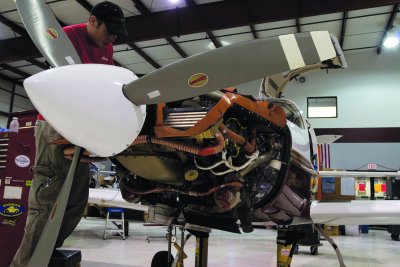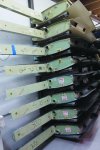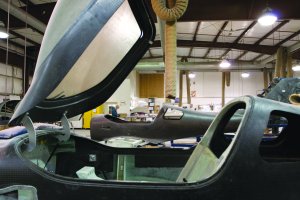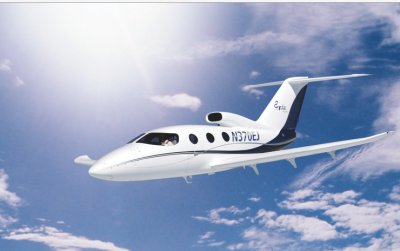 Last October, Indian billionaire Dr. Vijay Mallya — who founded India’s Kingfisher Airlines, one of the largest customers for Airbus — invested $200 million for a 50% stake in Epic Aircraft.
Last October, Indian billionaire Dr. Vijay Mallya — who founded India’s Kingfisher Airlines, one of the largest customers for Airbus — invested $200 million for a 50% stake in Epic Aircraft.
TAKING FLIGHT
 Epic’s Victory is an experimental kit-built plane with a base price tag of about $1 million. Epic’s Victory is an experimental kit-built plane with a base price tag of about $1 million.Photo courtesy of Epic |
Desire for smaller, faster, cheaper planes fuels a growing composite aircraft industry centered in the Bend area.
By Kathleen Newton
Last October, Indian billionaire Dr. Vijay Mallya — who founded India’s Kingfisher Airlines, one of the largest customers for Airbus — invested $200 million for a 50% stake in Epic Aircraft, a high-performance kit-airplane manufacturer that has been making industry waves from its Bend headquarters.
Mallya and Epic president and CEO Rick Schrameck immediately announced plans to build certified aircraft to feed the demand for fast, sexy personal and corporate aircraft in North America and Asia.
Then in late November, general aviation icon Cessna paid $26.4 million for another Bend company — Columbia Aircraft — a bankrupt manufacturer of fast single- and twin-engine general aviation aircraft.
For decades, Oregon flew under the radar of aerospace manufacturing as defense contractors and commercial aircraft firms in California and Washington led the industry. The only players in the state were Boeing’s component plant in Gresham and Van’s Aircraft, which produces experimental aluminum aircraft kits at its facility in Aurora. (Experimental aircraft is rated airworthy, but not fully certified by the Federal Aviation Administration.) The rest of the field consisted of parts makers.
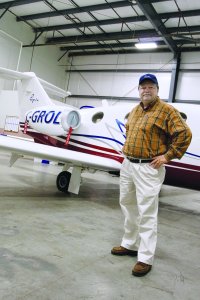 Dave Hice, Epic general manager. Dave Hice, Epic general manager.Photo by Lance Hardy |
But that’s changing as several new aircraft makers have come to Oregon in recent years, bringing with them experience with advanced-composite technologies. Now that experience is placing them directly in the path of industry growth.
A composite-aircraft manufacturing cluster has blossomed in Bend, and others are emerging in Scappoose and the Columbia Gorge, evidence of a boom in Oregon’s $1.6 billion aerospace sector. Although state employment officials estimate industry jobs at fewer than 3,000, experts say that figure doesn’t reflect the full impact of parts makers and service companies in areas from Portland to Salem, Astoria, Albany, Scappoose and Clackamas. Many are reporting banner sales. (See sidebar, page 24.)
This activity, along with the recent flurry of investments in Oregon companies, suggests that the state may be on the brink of securing a global presence in the manufacture of advanced-composite aircraft.
The move to composite aircraft is being driven in large part by the rising cost of fuel. Aircraft made from composite materials are lighter and more economical to fly. The American Composites Manufacturers Association reports that nationally the use of composites in aircraft is growing at a rate of 20% annually. Helping to fuel this growth are new categories of light jets and sport aircraft recently authorized by the FAA.
These new aircraft also feature cutting-edge electronic instrument systems that put enriched flight and navigation control data at a pilot’s fingertips. As a result, the new aircraft are smaller, lighter, faster, safer, more cost-effective and easier to fly than in decades past.
It’s a trend that seems little hampered even by a shortage of skilled workers and the rising cost of plant development.
|
OREGON’S NASCENT AVIATION sector until recently was largely unknown and focused primarily on build-it-yourself experimental kit aircraft.
Things began to change around 1990, when Lance Neibauer, a California entrepreneur who manufactured high-performance, kit-built experimental aircraft made from advanced composites, let it be known he was looking for an affordable plant site. Neibauer, who now lives in the Bend area, recalls that officials from Redmond pestered him for months, eventually winning him over.
“There is good flying in central Oregon,” he says. “I decided, since we could go anyplace for our plant, it might as well be a nice place.”
So Redmond became the home of Lancair International. Eventually, Neibauer branched out to build certified aircraft and founded Columbia Aircraft down the road in Bend. Its planes — also molded from lightweight, advanced composites — became highly coveted by performance junkies. The Columbia 400 model, priced at between $490,000 and $600,000, holds the title of world’s fastest certified piston-driven airplane.
The Bend cluster grew again when Greg Cole, an engineer who had worked for Lancair, founded Windward Performance there and began building composite-based sailplanes. Aircraft parts and service enterprises also set up shop nearby.
Then came Epic Aircraft.
Rick Schrameck, a turnaround specialist who had made his fortune in Silicon Valley, had owned two Lancair planes. He believed that U.S. general-aviation manufacturers were out of touch with customers. So he decided to design a line of fast, hot-looking, kit-built experimental aircraft that his customers would build and fly. He would use his customers’ feedback — and the kit-sales cash flow — to work out the design kinks, and then invest that into a line of planes that could be government certified. And he’d do it all in a relative nanosecond, by aviation industry standards.
Schrameck engaged Lancair to help him develop his prototype and opened the Epic Aircraft plant in Bend in February 2003. His line eventually included both prop planes and light jets. By 2005, Epic was already in the black.
To get around the tortuously slow process of FAA certification in the U.S., he began working with Canadian officials in Calgary to get his planes certified there — a process still under way.
People took notice — among them Indian liquor and airline mogul Dr. Vijay Mallya. He and Schrameck plan to sell Epic’s certified airplanes to private and corporate customers in India, where distances are vast and good roads are not.
According to Schrameck, that market alone promises to generate from $200 million to $400 million in annual sales. And some of that production may be done in Oregon.
Schrameck says sales of his kit-built light jets, which are priced in the $1 million to $2.5 million range, also are exceeding expectations: During two 2007 aircraft shows, Epic wrote $63 million in orders. The company plans to manufacture 30 of its kit aircraft in 2008 and has a two-year order backlog.
High-rollers, fed up with flying commercial and willing to put in some weeks at the Bend plant building their planes under the watchful eyes of Epic technicians, are discovering that the small jets can get them where they want to go fast, in style and for not much more than the cost of a beach house.
“We are seeing that our particularly unique segment of the market is incredibly strong,” says Schrameck.
|
BUT WHILE EPIC WAS SOARING, Columbia Aircraft across the street was facing cash-flow problems. This past fall, the company filed for bankruptcy protection after a series of problems that included poor cost containment, inadequate productivity and a hailstorm that damaged dozens of planes. Several potential buyers, including composite aircraft maker Cirrus, jockeyed to buy the assets. Cessna was the ultimate winner.
Some locals expressed concern that the sale might mean hard times for Bend’s aviation cluster. Cessna’s management, however, says jobs won’t be eliminated. Cessna CEO Jack J. Pelton had been eyeing the acquisition for at least a year. He wanted to enhance Cessna’s line with Columbia’s two models, the 350 and 400, which are faster than anything Cessna was building.
According to Cessna spokesman Doug Oliver, many Columbia owners were former Cessna owners who made the switch when they wanted to step up to high-performance planes. Cessna, whose entire existing line was made of aluminum, was also buying Columbia’s composite expertise.
“I’m sure we both have things we can learn from each other,” he says.
|
According to Oliver, there are no plans to move the plant — now adorned with a Cessna sign — out of Oregon. Its 400 employees will be retained, and more may be added. Oliver says the goal is to increase production from its current level of one plane a week to 200 or 250 a year, for potential sales of $100 million or more annually.
Dave Dennis, CEO of Oregon Aero in Scappoose, says he is preparing for a huge spike in his composite aircraft parts business in light of the Cessna deal. Oregon Aero provides certified seats for Cessna planes.
“We have so much explosive growth going on. The general aviation business is really opening up,” he says.
The manager for one of Boeing’s parts suppliers, PECO, which does $60 million a year making parts from advanced-composite materials at its Portland plant, also sees exciting times ahead.
“Over the past 40 years, the aircraft industry has generally gone in 10-year cycles,” says PECO’s business unit manager Dave Freund.
“Now it has just taken off in a new direction and I haven’t seen much to indicate that it is going to peak anytime soon.”
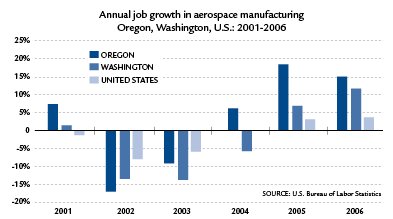 But the composite aircraft makers are still dwarfed by the scale of Boeing’s 120-acre Gresham facility, where the company’s 1,575 workers produce large structural components that go into all of Boeing’s commercial aircraft. The plant, where the rows of aluminum alloy components look like a gleaming dinosaur bone yard, uses 308 Oregon suppliers and contributes an estimated $174 million to the state’s economy.
But the composite aircraft makers are still dwarfed by the scale of Boeing’s 120-acre Gresham facility, where the company’s 1,575 workers produce large structural components that go into all of Boeing’s commercial aircraft. The plant, where the rows of aluminum alloy components look like a gleaming dinosaur bone yard, uses 308 Oregon suppliers and contributes an estimated $174 million to the state’s economy.
Boeing, however, has no plans to grow that facility.
“This industry is cyclical,” explains plant manager Jenette E. Ramos. “So we’re being very careful about our growth. I’d like to think of us more as being a stable business for the long term. We’re really trying to improve our productivity within the confines of the walls that we have today.”
| ||||
DESPITE ITS RECENT GROWTH, Oregon’s aerospace sector is not without its potential perils.
According to Joseph C. Bartels, the new owner of Lancair, which does about $15 million a year building airplane kits at its Redmond plant, further expansion of Bend’s aircraft manufacturing cluster could be hampered by rising land and development costs.
He says he had to give up on one expansion plan because of high land costs and planning hurdles. “There is a very high cost of living in Redmond,” he says.
Company founder Lance Neibauer agrees.
“Bend has changed, and not for the better,” he says “Now it’s a destination resort. You don’t do manufacturing in Aspen.”
Neibauer says that, if he were planning to build or expand a plant now, he would instead look to lower-cost areas.
“I might look to Baker or La Grande or Prineville,” he says.
But experts say the greatest challenge to sector expansion may be the scarcity of skilled workers.
“This is a new industry,” says Neibauer, who grew his workforce largely by training his own employees.
“We did have some composite training through Central Oregon Community College for a while, but that went away.”
In most cases, composite companies have addressed their labor issues by growing their own — a process that Neibauer says can take six months or more.
Robert Whelan, senior economist with Portland consulting firm ECONorthwest, agrees that industry growth may depend on solving the workforce problem.
“Frankly, if we had the people, Oregon’s aerospace industry would be much bigger.”
Kathleen Newton is a journalist based in Tillamook. She has been a business editor at The Los Angeles Times and owner of two Oregon weekly newspapers.
Have an opinion? E-mail [email protected]

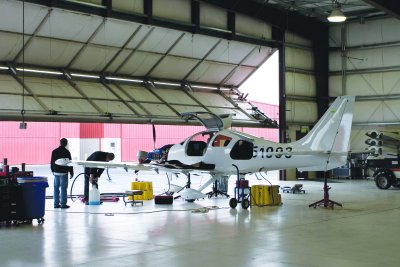
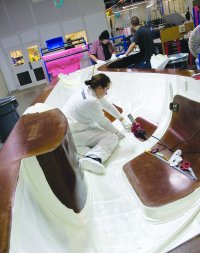 Photos by Lance Hardy
Photos by Lance Hardy